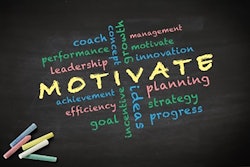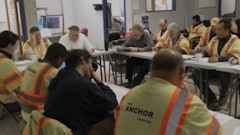
What do you think of when you read the first two words for the title of this article?
Energy Management
Come on now, don’t you think of a “power bar” that guarantees increasing energy, strength and coordination? Or maybe you think of some energy supplement that you mix with a shake or sprinkle over your breakfast cereal. However, when a construction leader recently asked me about “energy management” my response was way off base.
Ok, when my contractor friend asked me what I thought of or knew about energy management, and because I know that he’s sort of a mechanical thinking kind of person, I initially responded that he was referring to how to maximize fuel utilization for his vehicles and equipment. When I provided my response he shared with me that he was really talking about “human energy” utilization. (Maybe the energy bar wasn’t so off base after all!)
Call me “stupid” at what this term meant, but the more I thought about it the more I began to see what my friend was asking about. My contractor friend asked me to do some research on this topic and to address it through one of my articles. Let me share with you now what I have uncovered thus far.
I certainly don’t want to admit that this article is everything you’ll ever need to know about energy management for humans, but I think you’ll be able to build upon some of the things I have uncovered.
Energy Management, viewed through the eyes of our work efforts and output, is quite honestly a great term to use when addressing how wisely any construction worker, leader or laborer expends her energy and focus in a given period of time.
In short, Energy Management is about working on tasks and duties requiring the most of your full attention when you are at your energy’s highest potential output. Because we cannot always be at our highest energy and focus, we need to carefully prioritize what we are working on, perhaps even delegating tasks to those who might be working at their higher energy and focus level.
Already you can tell that your energy, focus and attention are key to producing greater results. And, though time management is part of this discussion, it is not the singular contributor — nor is it even the dominant theme.
Energy Management represents several components, all of which play some role in our overall output. Consider a few “energy components” that I’ve discovered since studying this interesting perspective on leadership:
- Energy “ups and downs” during the work day
- Impact made on performance by rest breaks, including lunch
- Attitude and enthusiasm as contributors to focus
- Clarity of the day’s mission and recognizing weekly goals
- Preparation for known daily “headaches”
- Chemistry among workers and the degree of synergy or teamwork
- Time allowances for scheduled tasks — and are they realistic?
- Pure diet including are you eating and drinking healthy?
Considering the list of potential contributors to how we manage our work energy, you can see that this opens up a lot of areas for us to ponder about how to get the most productivity, in a safe manner, from ourselves and our workers. This is less about pushing harder and more about leading smarter.
Let’s take each of the contributors listed and briefly explain how it might be observed. Then, we’ll consider perhaps a few techniques that might strengthen the overall management of the energy in action, resulting in finished work that is right the first time in the amount of time we’ve scheduled.
We’ll look at our first two contributors in this article.
Energy “ups & downs” during the work day
Ok, we all have those periods of time each day when we would just about give anything to take a little “power nap.” It is said that President John F. Kennedy took a brief, 10 to 15 minute nap most days while in the Oval Office. While we’re not the President of the United States, we too have those brief minutes each day when just a few moments of “shut-eye” would actually re-energize us.
For many construction leaders, their “up-time” of energy is early morning. However, come about mid- to late morning, when our workers are finding their daily rhythm, leaders can sort of drift a bit for 20 to 30 minutes. I’ve found that this can reappear mid-afternoon as well, but a renewed energy boost seems to return about the time our workers are shutting things down for the day.
This observation should not be too much of a surprise. Often, the mornings are energetic and require leadership that moves workers out of the shop or yard on time (or earlier) to get a good jump on the day’s project. And, many contractors want to be “up” for their returning workers, offering words of encouragement, checking on problematic equipment and getting the workers prepped for the next day of work.
If this first contributor sounds familiar, let me offer a few ideas that might just pump some more energy into those “down” times:
- First, learn what your high and low energy times are during the day (You might need to track this for 15 to 20 work days to find the average times during day.)
- Recognize your “down” times and avoid making critical decisions or attending critical meetings
- Ok, give in and eat or drink some quick energy item if you’re sharpest of senses is required during an energy “down” time
- Schedule your most important of tasks, meetings, calls, etc., during your higher energy periods
- If possible, eat a lighter lunch and employ exercise during the mid-day period to refresh your body and mind
- If you’ve been sitting for more than 30 to 45 minutes, get up and walk for several minutes, refresh your coffee and just clear your head
- When you receive a call during one of your lower energy times, get up and walk during the conversation
- Try standing more often when in meetings or conversations during your low energy periods
Ok, I don’t want to sound like some goofy health and exercise nut but there is something to retraining your mind and body to fight through periods of lower energy. It’s not rocket science, however, you will need to honestly address what your high and low energy times are and protect your really important “stuff” to be completed during your higher energy time periods.
Likewise, knowing that we all must work through our lower energy levels, we need to create some mental and physical “distractions” that assist our efforts to pick up our energy, our focus and our performance effort.
Impact made on performance by rest breaks, including lunch
Most contractors practice a morning and afternoon break along with the mid-day lunch break. For many, these morning and afternoon breaks range from 10 to 20 minutes, with lunch breaks averaging 30 to 45 minutes, sometimes an hour.
I realize that union labor has mandatory break times as part of their working contract. For the private and nonunion contractor, some crews might work through any one of the three breaks depending on their work situation, weather, personnel, etc.
It is interesting to me that often just about the time a crew of workers are finding their rhythm for the day, it’s time for that 10 to 15 minute break. This often does break up good performance efforts and can — not always but can — break the energy and focus, possibly leaving the crew with taking another 20 to 30 minutes to regain their productivity levels.
Now, since most contractors do expect their workers to take some form of break, as they should, how can we prevent a total implosion of energy management? Keep a few suggestions in mind that I’ve found has worked for many contractors and their field leaders.
- Keep the break area closer to where the workers are performing; long walks tend to extend break times and tend to encourage day-dreaming (a real toughie to get back on the work track)
- Just prior to the end of the break, have the crew leader calmly remind the workers on what their goals are, who’s working where and what is needed by lunch or end of the day
- If possible, provide your workers with bottled water and stay away from soft drinks or allowing your workers to walk off the jobsite to buy a soft drink, chips, etc. from the convenience store that always tends to add another 5 to 15 minutes to break time
- During lunch breaks, have your crew leaders pass through their workers 5 to 10 minutes prior to the end of the break, taking a visual inventory on who’s napping, still eating, cleaning up, etc.
- During those same lunch breaks, have your crew leader conduct a mid-day “huddle” to review where the crew finished up before lunch, where they need to begin after lunch and what their production targets are for the end of the day
- During the afternoon break really take note of energy left in your workers compared to what is needed to finish the day’s work; consider reassigning “who does what with whom” to make sure you have your higher energy level workers addressing those tasks that most need such attention
- If you witness things really slowing down between afternoon break and quitting time, call an immediate “time out” and wake up the crew to what you need their full attention to be focused upon completing
Instead of giving all of your low energy workers some instant energy boost drink, stir their attention up a little, even to the point of causing them to take a step back a moment to wake up to your alert. That’s better than allowing them to just ease into the finish in the lower energy mode that seldom achieves greater results.
To better schedule your day, your priorities and your focus, it just makes sense to be better acquainted with your energy trends and those of your workers. Such insights will yield much wiser decisions and better performance results as you purposely match workers — and their energy trends — with work tasks and process.
Start today and monitor your own energy over the next few weeks. Do your own “mini-lab work” to determine what portions of your day are more or less energetic. And, keep an energy bar close by…just in case.
Here’s to better Energy Management!




















